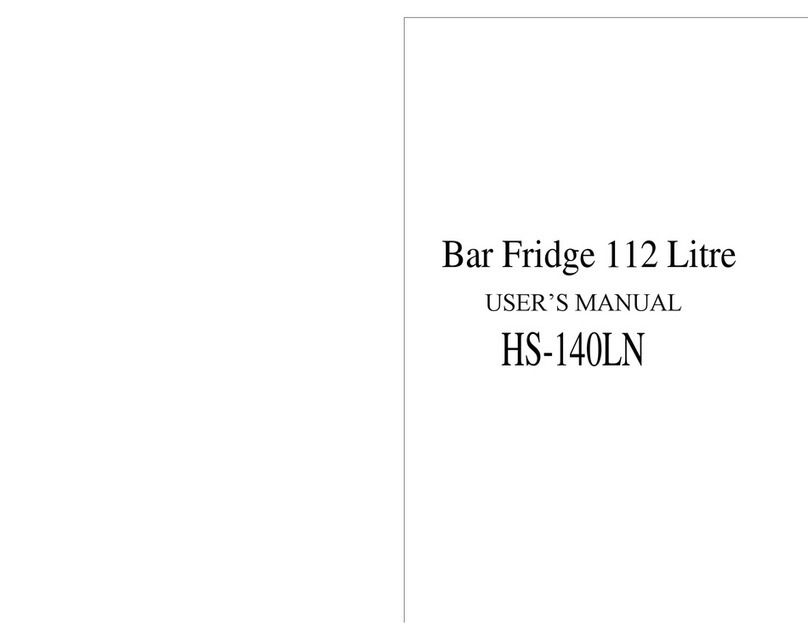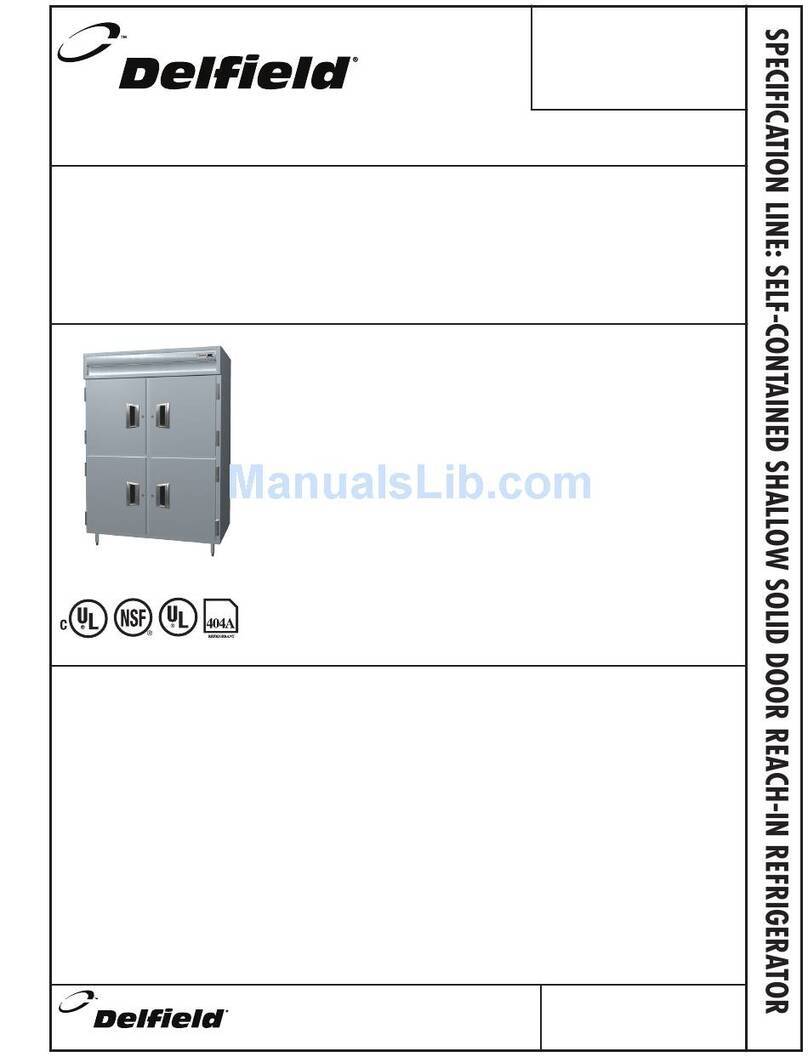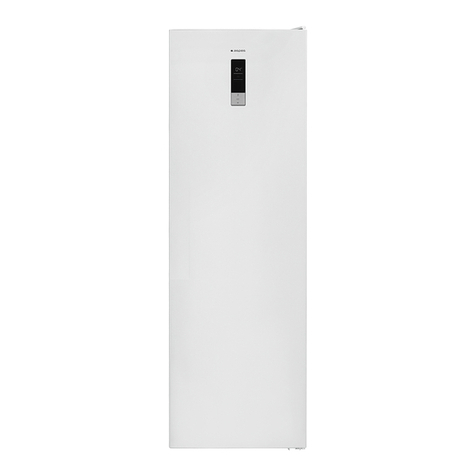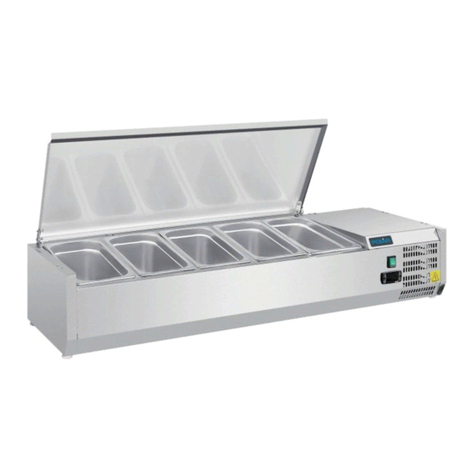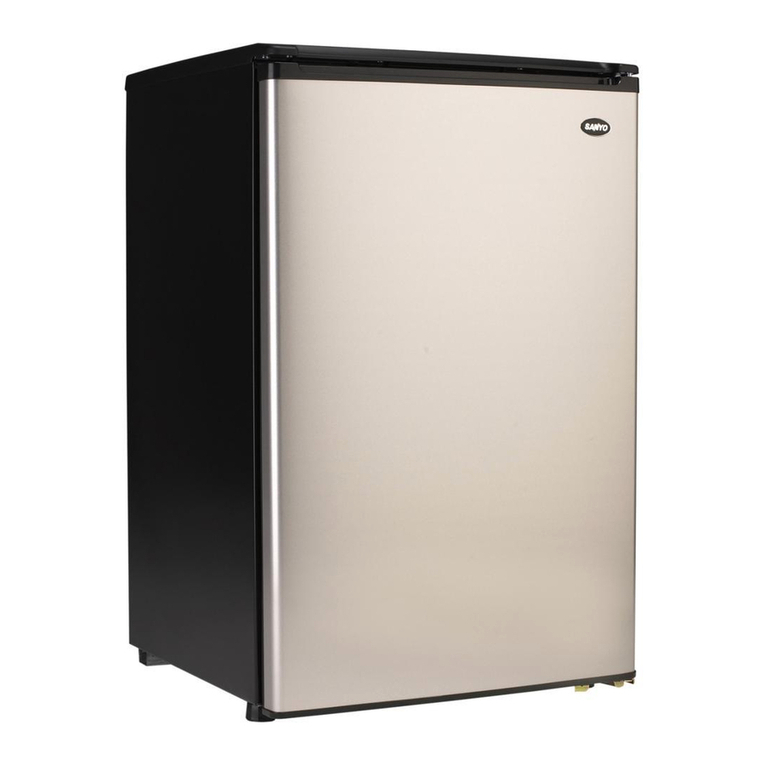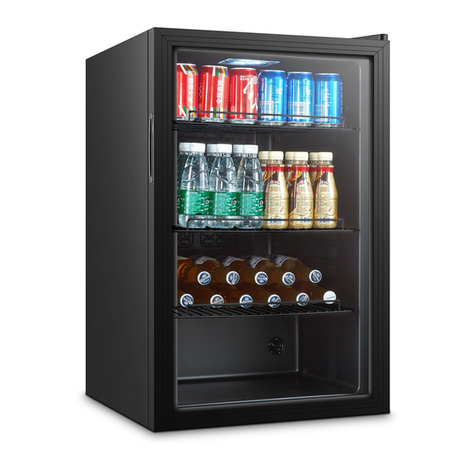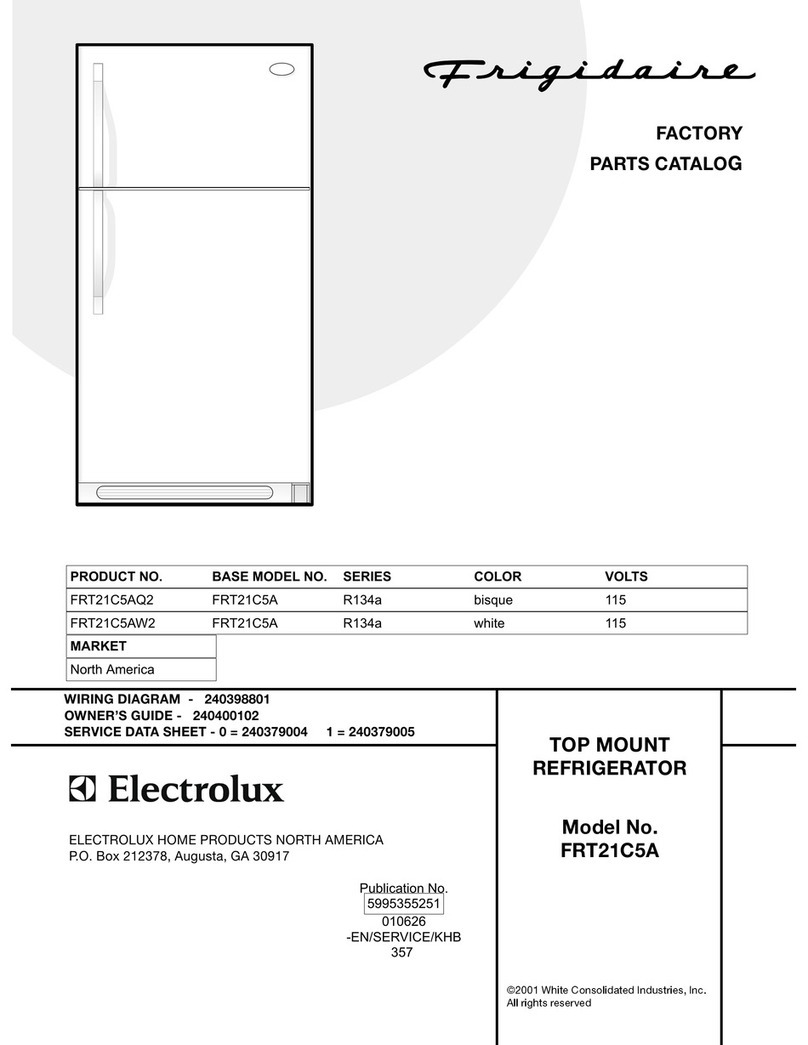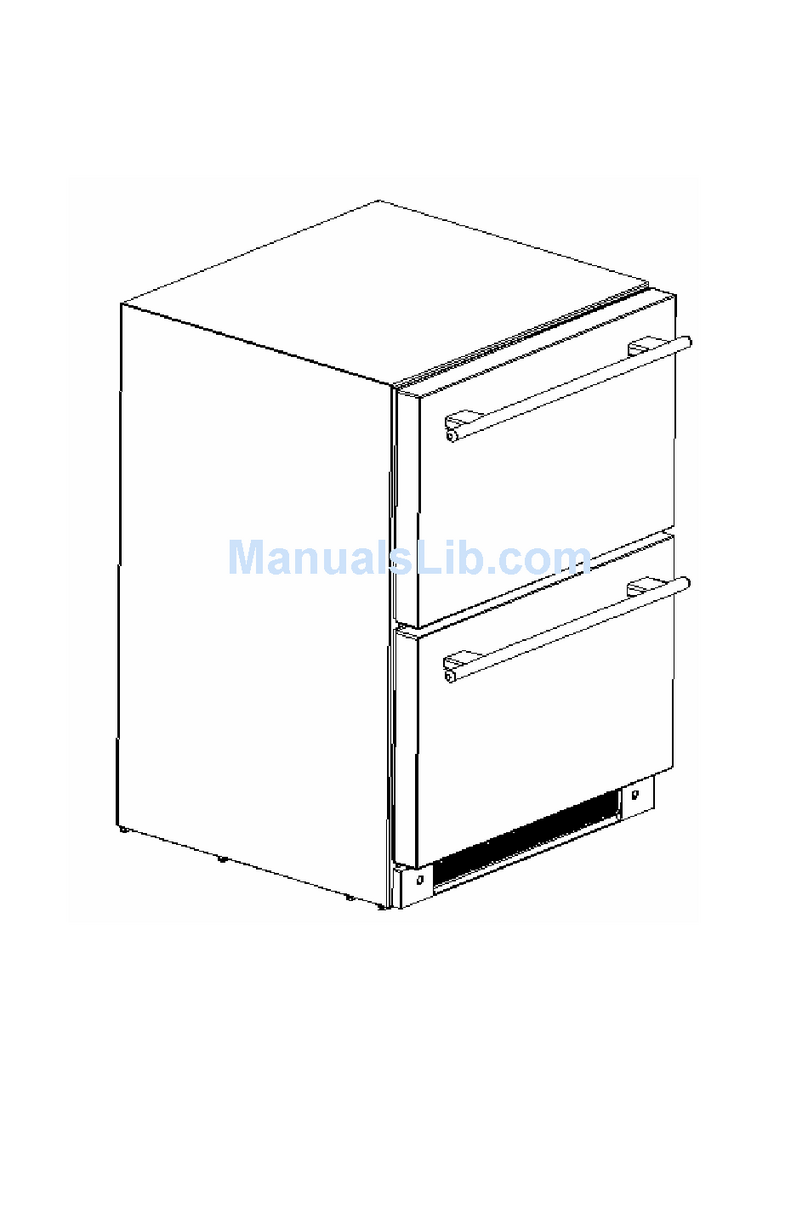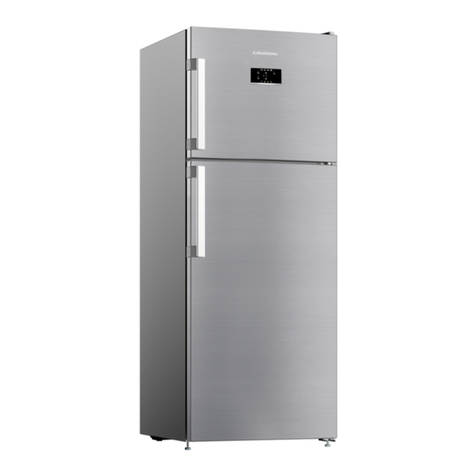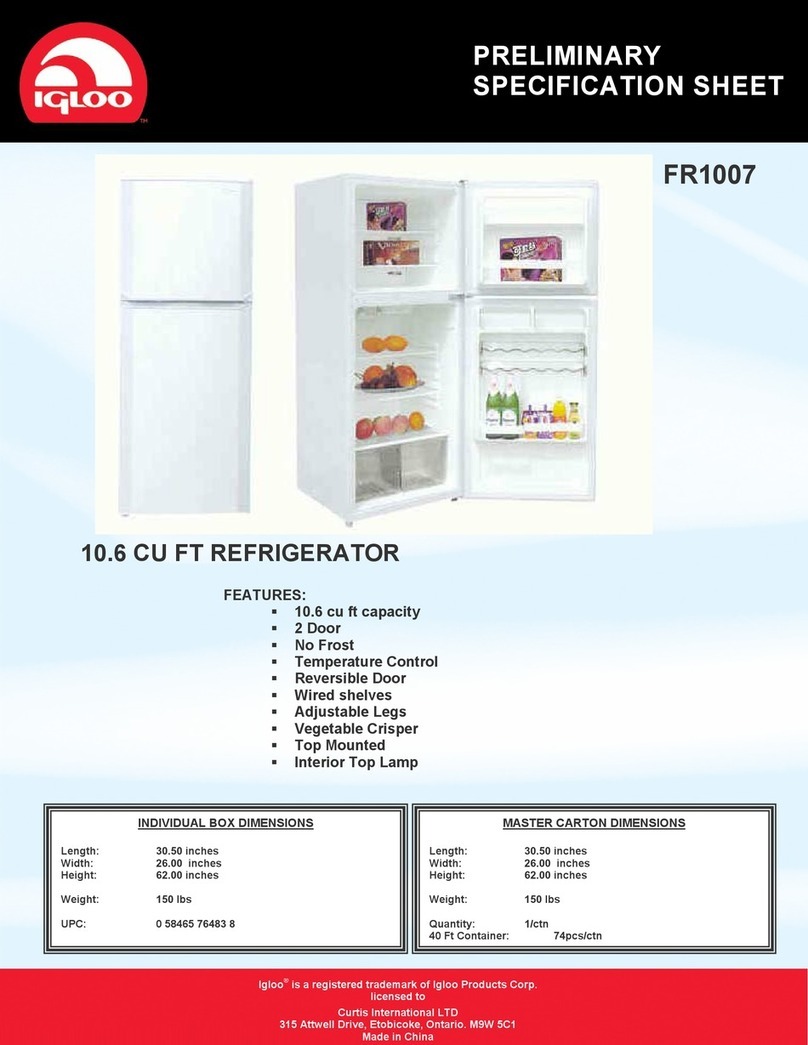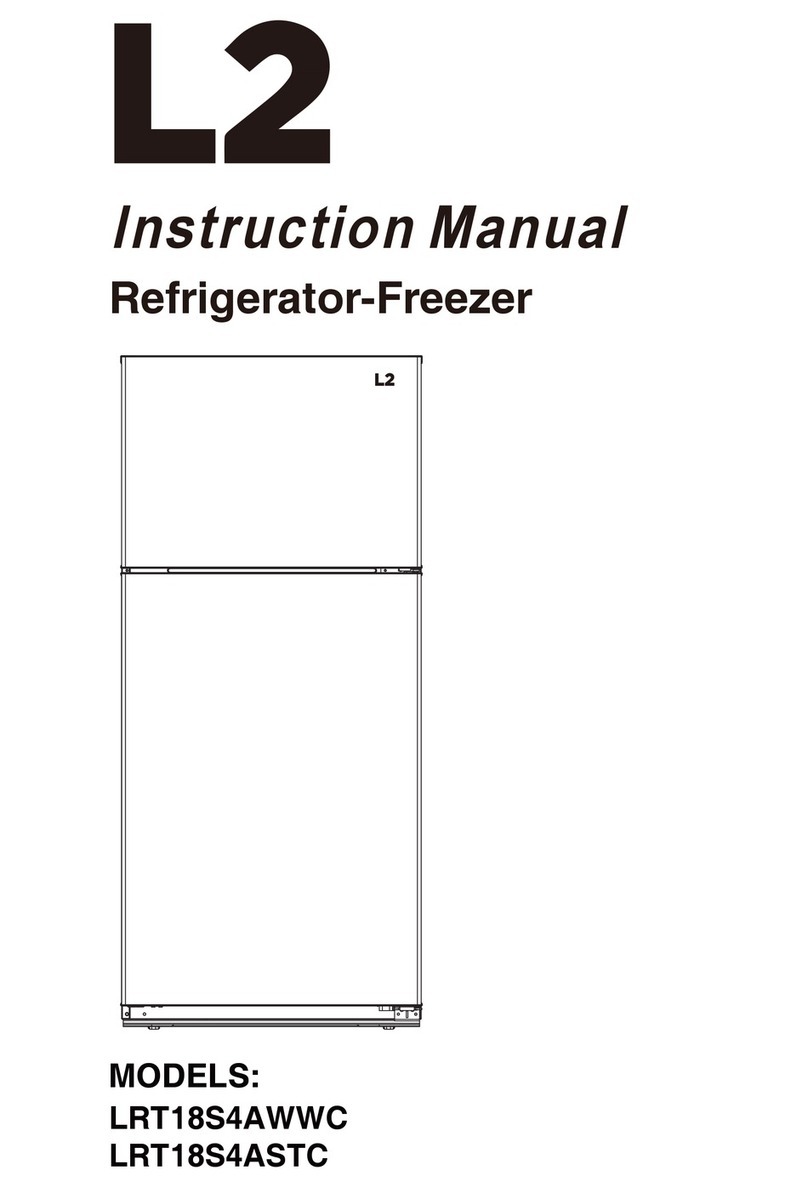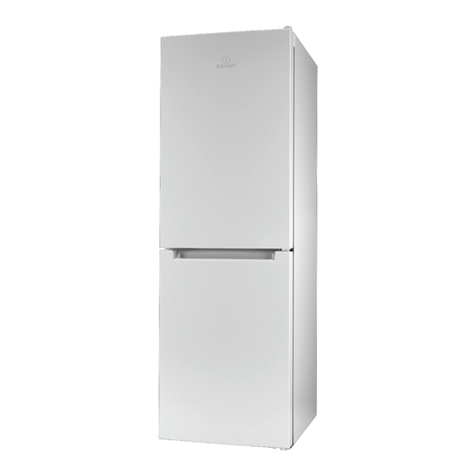Tisira TS65LN User manual

Otisira
Refrigerator
USER'S MANUAL
MODEL: TS65LN

General
This appliance is intended to be used in a
household and similar applications such as
—
staff kitchen areas in shops, offices and
other working environments;
—
farm houses and by clients in hotels,
motels and other residential type
environments;
—
bed and breakfast type environments;
— catering and similar non-retail applications.
This type of refrigerator is widely used in places
such as hotels ,offices, student dormitories and
houses. It is mostly suitable for refrigerating and
preserving foods such as fruits and beverage. It
enjoys the advantages of small size, Lightweight,
Low electric consumption and easy use.
1

Instructions for Installation
1.Do not tilt the refrigerator for more than 45
°
form upright position during moving it. And do
not apply force on any part such as the
condenser and door to prevent the refrigerator
from deforming, or else it will influence its
performance.
2.Let the refrigerator have enough space to work
well.
3.Don't install it in high temperature of humidity
place so as to avoid being damaged, dampened
and rusted.
Cautions for Safety
1.Before the refrigerator is plugged in check in the
electric voltage to be used fit is the same as the
rated voltage. The power plug should have its
independent socket, adapter may cause the
socket overheat.
2.Don't store inflammable materials such as ether,
benzine, LP gas and glue etc in the refrigerator.
3.Don't splash water on the refrigerator, it may
arouse malfunction or electric shock.
4.When gas leaks from its container. Don't pull the
plug out or in. It may arose sparks and fire
calamities.
5.
This appliance is not intended for use by
2

persons (including children) with reduced
physical, sensory or mental capabilities, or
lack of experience and knowledge, unless
they have been given supervision or
instruction concerning use of the appliance
by a person responsible for their safety.
6.
Children should be supervised to ensure
that they do not play with the appliance.
7.
If the supply cord is damaged, it must be
replaced by the manufacturer, its service
agent or similarly qualified persons in order
to avoid a hazard.
8.Keep ventilation openings, in the appliance
enclosure or in the built-in structure, clear of
3

obstruction.
9. Do not use mechanical devices or other
means to accelerate the defrosting process,
other than those recommended by the
manufacturer.
10.Do not damage the refrigerant circuit.
11.
Do not use electrical appliances inside
the food storage compartments of the
appliance, unless they are of the type
recommended by the manufacturer.
12.
Do not store explosive substances such
as aerosol cans with a flammable propellant
in this appliance.
4

Disposal
1.
Old appliances still have some residual
value. An environmentally friendly method of
disposal will ensure that valuable raw
materials can be recovered and used again.
2.
The refrigerant used in your appliance and
insulation materials require special disposal
procedures. Ensure that none of the pipes on
the back of the appliance are damaged prior
to disposal. Up to date information
concerning options for disposing of your old
appliance and packaging from the new one
can be obtained from your local council
office.
5

1 Ot t„te
„
'
4
14:
tis tre",
Instructions for Use
1. When operating the refrigerator for the first time,
run it without loading any food until it autos
tops at the desired temperature. Usually it takes
2 or 3hours,then set the thermostatic dial at the
setting desired and put foods in the refrigerator.
2.The temperature of the refrigerator can be
adjusted by turning the thermostatic dial. A
medium setting of the thermostatic dial is the
most suitable for general operation.
3.Defrost the freezing compartment whenever the
layer of frost on the surface of the evaporator
reaches 3 or 4 mm. When defrosting remove all
food and set the thermostat at "OFF" position.
Put the drip tray under the evaporator to collect
melted water. After the frost has melted, discard
the melted water and dry up the interior of
refrigerator. The refrigerator can then be
restarted by turning its thermostat to the desired
setting.
6

Cautions for Use
1. Do not place excess food in the refrigerator nor
leave the door open for long period of time,it
will creat excess consumption of energy which
will lead to a malfunction.
2.Do not to place objects which are too
heavy ,pointed or corrosion on table board.
3.Do not re-plugging in the power plug at the
interval of over ten minutes.
4.Do not store bottled drinks in the freezer, so as to
prevent from being broken and damaging the
refrigerator.
5.0pen the door as least as possible during
power-cut.
6.When defrosting, never use any sharp or metallic
objects to remove the frost on the surface of the
evaporator as it will damage the evaporator.
7.Don't touch foods and containers in the freezing
compartment with your wet hands so as to
prevent from being frostbitten.
Maintenance
1.While cleaning the refrigerator. pull out the
electric power plug, rub carefully with a piece of
cloth soaked with natural cleanser then wipe
with clean water. Abrasive cleaning power,
alkali cleansers, chemical cloth, thinner, alcohol,
acid petroleum product and hot water are not
7

suitable for cleaning the refrigerator, they may
damage the painting cover and plastics.
2.The door gasket may become dirty and fogged
easily, so clean it frequently.
3.If the refrigerator is out of use for a long time,
please pull out the plug, clean and dry the
freezing compartment then close the door
tightly.
The following cases are not malfunction
1.A flowing water sound:
Flowing water sound will be heard under normal
operation.
2.Outside condensation:
Outside condensation is normal in high humidity
condition. You may just wipe it up yourself.
3.It takes some times for the temperature of the
freezer and refrigerator compartments to become
cold after the refrigerator starts to operate: If the
temperature of the two compartments is higher
while the refrigerator is operating, it takes some
times for the temperature of the two
compartments to become cold. If the
environmental temperature is higher, it takes a
long time to make the compartments to become
cold.
4.The surface of the compressor becomes hot:
The surface of the compressor may become hot
under normal operation. Don't touch it with
8

hands.
Methods of inspecting malfunction
If any case of malfunction happens, please
inspect and dispel it according to the methods
shown in the following table.
case
Inspection
Is there no electric current?
Not
Is the voltage normal or not?
refrigerating
Has the socket fused?
Has
the
plug
been
put
in
effectively?
Is the thermostatic dial set to the
correct position?
Is
there
any
suitable
clearance
surrounding the refrigerator?
Has the door been opened too
Not efficient
frequently or too long?
Is
the
refrigerator
exposed
to
sunlight
directly
or placed
near
some heating devices.
Is
the food not cold out and too
hot to dace inside the unit?
9

Food frozen
in the
refrigerator
Compartment
Is the thermostatic dial set to the
correct position?
Is the compartment too full and
overcrowded?
Noises
Is the refrigerator installed firmly?
Has the refrigerator been struck by
some other objects?
Compressor
Cannot stop
automatically
Are the foods stored too much at
one setting?
Are
the
doors
opened
too
frequently or too long?
If the above methods are not yet effective, please
contact with the maintenance service department
for help without any delay.
DANGER or WARNING:
1. Risk of child entrapment. Before you throw
away your old refrigerator or freezer:
-
Take off doors.
-
Leave the shelves in place so that children may
not easily climb inside."
2. Do not use extension cords.
For household refrigerating appliances
Try not to open the door too often, especially when the weather
is wet and hot. Once you open the door, mind to close it as
soon as possible.
10

Every now and then check if the appliance is sufficiently
ventilated (adequate air circulation behind the appliance).
For household refrigerating appliances, in normal temperature
conditions, please arrange the thermostat at the middle setting.
Before loading the appliance with packages of fresh
foods, make sure they are cooled to ambient temperature.
Ice and frost layer increase energy consumption, so do clean
the appliance as soon as the layer is 3-5 mm thick.
If it is the outer condenser, the rear wall should be always
clean free of dust or any impurities.
Always consider instructions stated in sections Positioning and
Energy Saving Tips, otherwise the energy consumption is
substantially higher.
11
Other Tisira Refrigerator manuals
